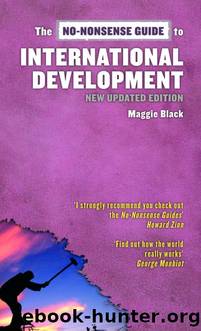No-Nonsense Guide to International Development, 2nd Edition by Maggie Black

Author:Maggie Black [Black, Maggie]
Language: eng
Format: epub
ISBN: 9781771131421
Google: LBfPBQAAQBAJ
Publisher: Between the Lines
Published: 2007-10-01T11:39:58+00:00
A new focus on software
Thus the upending of Western models for social advance provided the laboratory from which emerged todayâs development tenets: âparticipatoryâ, âdecentralizedâ, âempoweringâ, âknowledge transferâ and the rest. This was the âhowâ â the software ingredients which knocked from their pedestal the all-powerful hardware ingredients and their technical overlords â engineers, planners and scientists. The new emphasis on processes, their stimulation and their management, was a useful corrective to the old idea that development was all about buildings, installations and technological devices. But it also helped to introduce a degree of incoherence. If what a community wanted were a year-round water supply, a functioning village dispensary and a school with teachers, books, desks and pencils, it was hard for them to appreciate that a âknowledge transferâ or âattitudinal changeâ would do the trick. Tangible benefits were also needed, and sometimes the pendulum swung too far in the software direction.
However, in the course of flirting with alternative approaches or at least with some of their tenets, the diverse nature of âthe poorâ became more visible: poverty was not a uniform phenomenon and its victims could not all be lumped into one conceptual basket. The particular predicaments of women were increasingly recognized; children as a sub-group also become more noticed as an outcome of social disintegration and family breakdown. Concern was also focused on those threatened with indigence because of war or famine displacement, disability, family disaster, or chronic illness including HIV/AIDS. The circumstances of target population groups, and their existing beliefs, attitudes and practices, began to be accommodated in planned activities in which they were to participate. The Master Plan approach gave ground to the plan developed on site and tried out on a small scale before going into overdrive.
The HIV crisis
The HIV/AIDS pandemic emerged in the 1990s. Since women and men in the prime of economic life are mainly affected, the infection devastates household economies and leaves children and the elderly without means of support. Africa has suffered disastrously, containing 70 per cent of those infected and 80 per cent of AIDS orphans. Of the five million new infections in 2004, one third were among young people aged 15-24, with girls and women especially vulnerable. In the worst affected areas, the under-five mortality rate is expected to double by 2010.
Download
This site does not store any files on its server. We only index and link to content provided by other sites. Please contact the content providers to delete copyright contents if any and email us, we'll remove relevant links or contents immediately.
What's Done in Darkness by Kayla Perrin(25490)
Shot Through the Heart: DI Grace Fisher 2 by Isabelle Grey(18208)
Shot Through the Heart by Mercy Celeste(18151)
The Fifty Shades Trilogy & Grey by E L James(17767)
The 3rd Cycle of the Betrayed Series Collection: Extremely Controversial Historical Thrillers (Betrayed Series Boxed set) by McCray Carolyn(13179)
The Subtle Art of Not Giving a F*ck by Mark Manson(12896)
Scorched Earth by Nick Kyme(11821)
Stepbrother Stories 2 - 21 Taboo Story Collection (Brother Sister Stepbrother Stepsister Taboo Pseudo Incest Family Virgin Creampie Pregnant Forced Pregnancy Breeding) by Roxi Harding(11013)
Drei Generationen auf dem Jakobsweg by Stein Pia(10208)
Suna by Ziefle Pia(10176)
Scythe by Neal Shusterman(9249)
International Relations from the Global South; Worlds of Difference; First Edition by Arlene B. Tickner & Karen Smith(8599)
Successful Proposal Strategies for Small Businesses: Using Knowledge Management ot Win Govenment, Private Sector, and International Contracts 3rd Edition by Robert Frey(8404)
This is Going to Hurt by Adam Kay(7680)
Dirty Filthy Fix: A Fixed Trilogy Novella by Laurelin Paige(6444)
He Loves Me...KNOT by RC Boldt(5795)
How to Make Love to a Negro Without Getting Tired by Dany LaFerrière(5366)
Interdimensional Brothel by F4U(5298)
Thankful For Her by Alexa Riley(5148)
